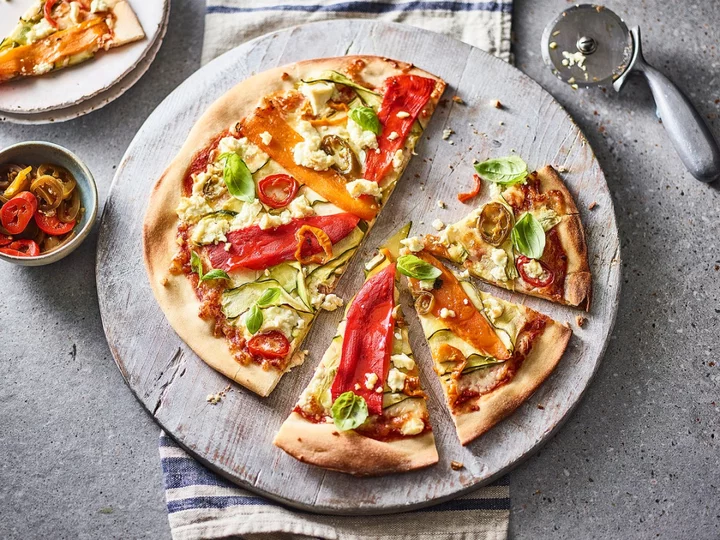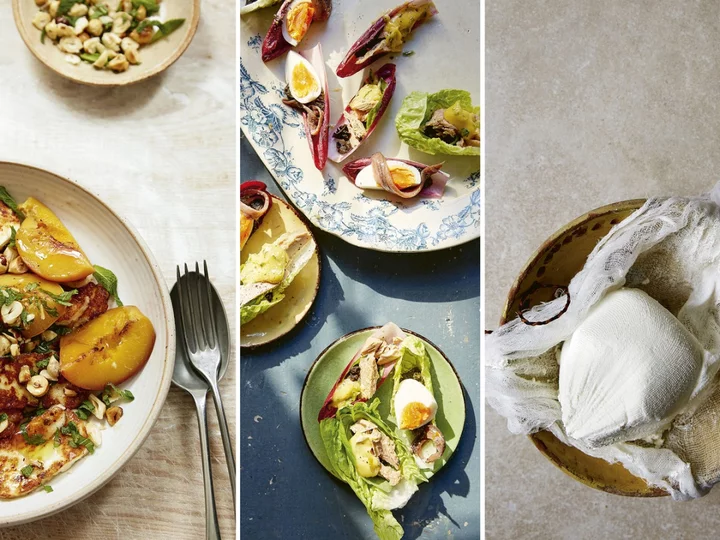
Canada media guide
An overview of the media in Canada, including links to broadcasters and newspapers.
2023-07-04 23:45

Ditch Deliveroo – make these healthy, 30-minute pizzas instead
Stop ordering pizzas on Uber Eats and get into the kitchen to make your own. These spicy feta, pepper and courgette pizzas from Cooks&Co will be hot and ready to eat long before a delivery driver gets there with your cold, soggy takeaway. Swap meat for vegetables and mozzarella for feta and you can call it a healthy win, too. Spicy feta, pepper and courgette pizzas Serves: 4 Prep time: 15 mins, plus defrosting | Cooking time: 12-15 mins Ingredients: 2 x 220g frozen pizza dough balls, defrosted 100g pizza sauce 200g grated mozzarella 1 courgette, cut into ribbons 150g Cooks&Co Roasted Red and Yellow Peppers, quartered 25g Cooks&Co Tri-colour Jalapeno Slices 100g feta To serve: Drizzle extra virgin olive oil Basil leaves Method: Preheat the oven to 240C/gas mark 9. On a floured surface, roll out each dough ball into a rough 30cm round and place on 2 large lightly floured baking trays. Spread with the pizza sauce leaving a 2cm border. Sprinkle with cheese and top with courgette ribbons, peppers and jalapenos. Crumble over the feta and drizzle with a little olive oil. Bake for 12-15 minutes. Drizzle with extra oil and scatter over a few basil leaves to serve. Cooks tip: Add spoonfuls of mascarpone instead of feta. For more recipes, visit cooksandco.co.uk Read More Three quick and easy vegan fakeaway recipes The dish that defines me: Eddie Huang’s Taiwanese beef noodle soup Nutritionist explains how women can eat to help balance hormones The only three recipes you need to seize the summer How to shop at Borough Market in the summer Budget Bites: Three light recipes that sing of summer
2023-07-04 18:23

This is how Novak Djokovic is preparing to win Wimbledon
Tennis won Novak Djokovic over when he was just four years old. Since then, the Serbian professional tennis player established himself as a reigning men’s champion. In July 2006, he won his first Association of Tennis Professionals (ATP) event, and reached the semi-finals at Wimbledon and the French Open a year later. The 36-year-old also advanced to the finals of the US Open in 2007, but lost in straight sets to the former Swiss professional tennis player Roger Federer. He managed to win his first Grand Slam tournament at the Australian Open and was awarded a bronze medal at the 2008 Beijing Olympics. Though Djokovic’s performance has plateaued at some points, his hot streak has continued over the last 16 years. He claimed his 21st Grand Slam championship after winning Wimbledon in 2022 and gained his 10th title at the Australian Open, crowning both him and Rafael Nadal with the most Grand Slam men’s singles championships. With the 2023 Wimbledon Championships in full swing until July 16, how will Djokovic prepare himself both mentally and physically to win? Diet Djokovic starts his day with raw celery juice — which has anti-inflammatory properties – and sometimes drinks it before, during and after matches. Celery is about 90% water, so it’s great for hydration first thing in the day, especially when you don’t feel like chugging down a glass of water. On other occasions, he drinks the green goddess smoothie, “which is a load of green things chucked in and blended. In the food industry, you can get green goddess dressings, sauces and juices, which all have kale, spinach, peas, mint, cucumber, apple and spirulina powder all blended into one”, says celebrity private chef Ethan Russell. And for breakfast, Djokovic would normally eat a power bowl — it’s got a lot of healthy fats, grains, and fruit in it — or have it as a snack before exercising. The clear number one rule is being gluten and dairy-free. “It’s a choice many athletes make, especially if they want to feel and perform their best. Gluten and dairy can cause irritation,” Russell says. There are so many different dairy and protein alternatives at the moment, such as coconut, soy and almond. “The bowl has different types of grains, gluten-free granola — with pumpkin seeds and goji berries — then a low sugar style muesli,” he adds.“If you are an athlete and trying to keep your sugar low, you can opt for dairy-free yoghurt and manuka honey, which is quite expensive and very sought after, with its anti-inflammatory properties. People use it in food and skincare, making it a super food. The bowl is then topped with blueberries and strawberries, packed with natural sugars.” Warming-up Djokovic would usually start warming-up with his physiotherapist, then move onto to mobilisation and movement exercises, to minimise the risk of major injuries. Warm-ups can be anything from the running man, squat reaches to the sky and lunge rotations, all of which encourage great blood circulation. A match can last one and a half hours, and there are so many things to manage on match days, according to Mark Taylor, who coaches British tennis player Ryan Peniston and also works at the Junior Tennis Coaching academy. “They play all year round and often under immense pressure. It’s why I also work with a sports psychologist,” he says. Mindfulness Djokovic is heavily into mindfulness, and might begin his day with silent meditating — especially if he’s got an important game to focus on — in a grounded way, to promote mental clarity, calm focus and energy. “Most of us find it difficult to sit still,” says Loren Peta, yoga teacher and personal trainer. “But gentle movement and box breathing — where you draw a box with your mind’s eye to help you stay present — is a great way to transition from a state of doing to state of being.” Whilst in conversation with former Spanish tennis player Alex Corretja at the The House of ASCIS event last Friday, Djokovic opened up about his mental health and wellbeing. “If we are talking about mental strength and preparation, and how it affects performance, I feel like half of the work is already done before you step out on to the court – also known as the battlefield,” Djokovic said. “It’s why I try to only peak at the biggest tournaments and take more time than I used to, to get my mind and body into perfect harmony. My body is responding differently than it was 10 years ago, so I have to be more specific with my preparation, work, training and recovery. I believe in a holistic approach to this sport, and everything else in life. “It’s about everything you do, eat, the relationships around you, how you perceive yourself, the traumas and emotions that are suppressed in you. I know for me, if I suppress something, it will always surface on the court. The more you put these things aside, the bigger the monster will become. “If you fail to prepare, it’s going to be a difficult mountain to climb during the match. Tennis isn’t a sprint, it’s a marathon as well.” Getting the right footwear There are certain things that are important to keep in your kit. But for Djokovic, his racket and shoes are the two most important items for every tennis player, especially at his level. Good shoes adapt to the way a tennis player moves their feet, to ensure the right support and exact comfort can be added, if required. For example, improved extra heel cushioning and ankle support. “The details [are important],” said Djokovic. “Every single thing matters. How you move, how you feel with your racket and shoes. You need to be comfortable with what you are wearing, because it’s going to help you perform and move better. “I probably move differently to most of the guys out there – even on grass, I slide. [So I need] really flexible shoes that allow me to stop when I need to stop, and change directions when I need to change directions. It can’t be too light or too heavy.” Read More Charity boss speaks out over ‘traumatic’ encounter with royal aide Ukraine war’s heaviest fight rages in east - follow live Money-saving ways to garden on a budget 8 budget-friendly ways to juggle childcare and work during holidays Dior’s couture show was the epitome of quiet luxury
2023-07-04 16:58

The dish that defines me: Eddie Huang’s Taiwanese beef noodle soup
Defining Dishes is a new IndyEats column that explores the significance of food at key moments in our lives. From recipes that have been passed down for generations, to flavours that hold a special place in our hearts, food shapes every part of our lives in ways we might not have ever imagined. My earliest memory of Taiwanese beef noodle soup is the first time I compared the version my mother makes and then going out to eat it at restaurants. It was just terrible outside the walls of my home, just a sad watery soup with no flavour. I was born in Washington DC but grew up in Orlando. In America, and even in some places in Taiwan, there are a lot of places that are lazy when it comes to making beef noodle soup. They just whip up a thin broth with ginger, spring onions, some type of chilli. Then there are other places trying to do expensive s***. They’ll try and promote it by saying, “Oh, I use dry aged beef” or “I use this super expensive stock”. But that’s all unnecessary. What Taiwanese beef noodle soup needs is time, not anything fancy. What do we do when we cook? We apply the right level of heat to the proper amount of time to the proper ratio of ingredients. That’s it. With this dish, the longer you let it simmer, the better it is. The flavour develops and becomes richer, the beef becomes fall-apart tender. It’s so simple and humble, all it takes is time. I make mine using two separate stocks. I make a master stock, which begins with simmering meat and bones for a long time so it becomes really flavourful. Then I make another stock with my aromatics – including ginger, spring onions, garlic, fresh chili peppers and dried red chili peppers, and Szechuan peppercorns – and sauces, like dark and light soy sauce and rice wine. Doing it separately allows me to strain the aromatics out and keep the broth really clean so that each bite is consistent. For the protein, I use beef shank and oxtail. The thing that sets my beef noodle soup apart is that I use chilli oil as well as fresh chilli for that acid kick. That’s something I haven’t seen other people do, most dishes use just chilli oil. I’m also quite loyal to tomatoes in my beef noodle soup. A lot of people make it with either tomato or no tomato, it’s one of those divisive things. People will ask, “Are you a tomato beef noodle soup guy or you’re not a tomato guy?” I’m a tomato guy because it gives the dish more umami and another layer of acidity. The chillies and tomatoes combined deliver different levels of acidity. Between those three, they cut through the fattiness of the beef. I don’t over-skim my soup either, I leave all the globs of fat in there to keep it rich, but the acidity stops it from being excessive. I’m agnostic about the type of noodle I use in my soup. I served it once to my homies with a really good number 10 Italian spaghetti, which is a finer noodle than regular spaghetti. They were like, “Yo, this is crazy”. It totally changed the dish, I’ve never had it like that. Most people use a Chinese wheat noodle, some do knife-cut noodles and others do hand-pulled. They’re all fine for me. I’m mainly here for the broth, which I’ll just drink a lot of the time. I do like knife-cut noodles though, I would love to try that. But mostly I will serve it with a Chinese wheat noodle or spaghetti, because it’s the closest you can get to wheat noodles if you can’t get them. The difference between my mum’s beef noodle soup and mine is that she doesn’t add the chilli oil and fresh chillies. But I have to say that my mum will tell you that my beef noodle soup smokes hers. It’s just that much better. She does not f*** with me anymore. There are certain dishes that I practice so much and she just says, “I’m not playing with you anymore, right?” But she’s still the best at home-style small dishes and stir fries, like baby dried fish with peanuts, red-cooked pork or lion’s head meatballs. But some other dishes, my mum gives me the nod. She doesn’t make them anymore, she’s like, “You make it”. It’s fun to say, “Alright, you taught me and I really, really mastered it”. I was never one to do it just like my mum. I was always going to learn how she does it and then I’m going to make it a little bit better. Beef noodle soup is incredibly close to my heart, it’s the only dish that occupied an entire chapter of my memoir, Fresh Off The Boat. I wrote at the time that the best part of beef noodle soup is that there are no rules and you can add whatever you like as long as it has the essentials: beef, noodle, and soup. I like it the most because there is nowhere to hide with this dish. Just take your time. Eddie Huang is the chef-founder of Baohaus. He wears many hats, including author, presenter and director. Read More Eddie Huang: ‘I’ll never eat at BAO London – I know mine’s better’
2023-07-03 23:28

Italy media guide
An overview of the media in Italy, including links to broadcasters and newspapers.
2023-07-03 22:15

Affected by someone else’s drinking? 3 key pieces of advice for loved ones of alcoholics
Is there an alcoholic in your life? We don’t often talk about the people whose lives have been affected by someone else’s drinking – but the impact on loved ones, family and partners can be immense. For Alcohol Change UK – the charity behind Alcohol Awareness Week (July 3-9) – it is important that loved ones of alcoholics know they are not alone. According to a new survey commissioned by the charity – which is not anti-alcohol but working towards ‘alcohol change’ and to reduce the harm it causes – some 19% of drinkers consider alcohol to be an “essential” in their shopping basket, with 15% of people worried about the amount of alcohol someone in their household has been drinking. “Far too many lives are tragically cut short each year due to alcohol, with the latest figures on the number of alcohol-specific deaths at a record high. At the moment, 600,000 people in the UK could benefit from alcohol treatment but the vast majority are not receiving it,” said Andrew Misell, Director for Wales at Alcohol Change UK. “It can be heart-breaking to see someone close to you struggle with alcohol problems. But it is not only the drinker who is affected – their loved ones can feel the effects too. The pressures of caring for someone who is drinking heavily can be overwhelming,” Misell adds. “But by encouraging them to seek support, you can really improve their health and yours.” Is somebody close to you an alcoholic? Here are some key pieces of advice that may be helpful… Visit your GP Seeing your GP could help you address any anxiety you may be grappling with. They can offer professional and nuanced advice that will help you communicate how you really feel to a loved one who needs to stop drinking, and steer you towards your own mental health support if necessary. “Living with someone who is struggling with an alcohol problem can be exhausting. You will want to do the best you can for your loved one, but your relationship with them is bound to be strained. You may no longer feel able to trust them,” Misell said. “They may well be neglecting family duties, and their moods may swing erratically. It’s important you find some time and space for yourself and for your own concerns and interests.” Also, anyone is allowed to contact the GP or safeguarding anonymously if, for instance, there is a parent with alcoholism looking after young children. Reach out to family support services Whatever your relationship with the person with an alcohol problem, other people will have had, or be having, similar experiences. Connecting with them at one of the many family support services across the country can be really helpful. “It may be worth you seeking out support from a families’ organisation like Adfam or Al-Anon, where you’ll be able to connect with others who are in the same boat as you,” Misell said. Bottled Up, meanwhile, offers information and advice for family members living with someone who is alcohol-dependent. The founders of the organisation are a therapist and a psychologist who have direct experience with alcoholism. Al-Anon provides free meetings where the family and friends of alcoholics can listen to the shared experiences of those in a similar positions. Al-Anon also has a separate arm for children aged between 12-17 called Alateen, where teenagers can share their experiences and find support, while also learning about the nature of the illness. Think about the four aspects of their health Before sitting down to talk about what is going on with a family member who is drinking too much, it might be a good idea to be prepared about what you need to say. This could be a helpful step in deciding what actions to take in order to seek help, too. Dr Niall Campbell, Priory consultant psychiatrist and addictions expert, based at Priory Hospital in Roehampton, southwest London, suggests thinking about these four aspects of their health first: physical health, mental health, relationship health and their work health. “Are they falling over? Have they injured themselves? Have they been drinking to the point of amnesia? Blackouts? Are they hungover and sick in the morning? Have they gone to see their GP? Some results, such as high blood pressure, could be a good indicator,” Campbell said. “And then mentally, is it making them depressed? Are they irritable? Do they seem ashamed or guilty? Is their drinking adversely affecting relationships between a husband and wives, siblings, children, and parents? “When it comes to their work, are they missing it? Are they late going into the office and saying they can’t do their job properly because they’re drinking at home? This is a big problem since the lockdown.” He suggests doing this with a third party that’s already aware of the situation, so you can pull together more concrete examples. Read More Charity boss speaks out over ‘traumatic’ encounter with royal aide Ukraine war’s heaviest fight rages in east - follow live The history of royal fashion at Wimbledon How to be waterwise in your garden this summer Every Barbie-inspired outfit Margot Robbie has worn so far
2023-07-03 16:58

Vivica A. Fox says Independence Day sequel was 'not good' without Will Smith
Vivica A. Fox has admitted failing to get Will Smith to reprise his role in the Independence Day sequel was a big mistake
2023-07-03 15:24

How to shop at Borough Market in the summer
Food markets fizz with a very particular kind of energy in the summer months. That’s as true anywhere as at Borough Market where the energy somehow hits me as I’m still walking the stairs up from London Bridge tube, way before I even see the market gates. It’s not just the sun’s moodlift that makes things palpably different in the summer than at any other time of year – it’s the distinctive culmination of the summer vibes that marketgoers bring. Whether seasonal cooks there to stock up on longed-for summer produce; friends on a wander for a day out; or food lovers after a few deliciously easy wins to enjoy on a rug somewhere. Any kind of picnic (garden/beach/park/lounge) can be so easily catered for at a food market. In one swoop you can pick up chilled bottles of interesting wines, beers and softs; breads for ripping into; butter and seasonal young cheeses; charcuterie; salty black olives, and all kinds of fabulous fruits. Tins of preserved fish make for interesting rug-chat over the beautiful boxes. At Borough there’s no shortage of choice of those at The Tinned Fish Market stall. Sometimes there I’ll go for the Cântara small squid stuffed with onion, rice and tomatoes; other times the Pepus mussels in escabeche. Or else it’s the never-fail Ortiz tuna at Brindisa, home to so many foods that are a picnic-maker’s dream. (Fino sherry, truffle crisps, jamon, salted almonds… do I need to go on?) That ease the food markets gift to feeding a gathering translates seamlessly to the ease they offer summer’s everyday cooking and eating. The stalls (almost) struggling to fit in all the magnificent seasonal produce that is so often best enjoyed when hardly anything is being done to it. Courgettes, peppers and aubergines gleam with proud beauty among the glory of all the other summer vegetables and fruits. Pods of garden peas and broad or borlotti beans beg to be bought by the bagful. All of them are a joy to mindlessly and mindfully pop out of the shells when you get home, but the borlottis perhaps most of all as that’s the only way to really be able to admire the purple mottles of the bean before it disappears upon cooking. The best seasonal tomatoes need little more than olive oil and salt to bring out their supreme flavour. Salad options are inexhaustible – go for big sharing bowls of a fattoush or panzanella; or the neat Nicoise bundles featured in Borough Market: The Knowledge. There the classic Nicoise elements of anchovy, mayonnaise, capers and egg are piled aboard little gem boats for ease of eating. Another of my all-time favourite summer salads is in that book too: oregano-poached peaches, halloumi and hazelnuts. Its mix of sweetly salty flavours manages to be simultaneously refreshing and completely beautiful on the plate. The peaches in it becoming the very best version of themselves by being poached with dried oregano and honey. The choice of honey is no accident. In the summer I always make sure to stock up at the market on blossom honeys that will delicately yet effectively infuse so many foods – and drinks – with a floral undernote. Perhaps the lavender honey at From Field and Flower, or the wild thyme at Oliveology. That’s the one I use in the dressing for making The Knowledge’s labneh with watermelon, honey and mint. It’s a recipe that straddles the boundary of sweet and savoury, with watermelon griddled in olive oil, orange and sumac for peak refreshment. My top tip in making this is to always do more labneh than needed in the recipe because it is such a useful thing to be able to reach for in the fridge. All it takes is 900g of really good, thick Greek yoghurt mixed with 1 teaspoon of salt and spooned into a muslin-lined sieve. Let that drain for 6-12 hours (depending how thick you want it – longer equals thicker) and the result is approximately 500g of labneh. Use it for salads, or to spread on toast with perhaps just a few sliced apricots. Summer is mackerel season at the market. A fish that is packed with flavour and goodness, and also incredibly easy to cook. Griddle it, bake it, fry it, or over-fire it. And then, when any kind of cooking seems impossible in the heat, even sit it in vinegar for a while and let its acidity do the “cooking” for you. Try the same thing with the small fresh anchovies that the fishmongers also have in now. They absolutely don’t need to be gutted, but the skilled fishmonger will happily do it for you (and at the same time showcase exceptional filleting knife skills). Whenever I head to the market on a produce-shopping mission it tends to be just that – a mission. I do try to make sure to spend time checking out what is what because the very nature of market shopping is that it is never the same. What the stalls offer week on week is at the mercy of not just the season but whatever choices traders have been made on what to stock that week, that day. Yet, as I beetle around, I am always a bit envious of the market wanderers. It’s a feeling that grows even stronger in the summer when these marketgoers without any agenda of shopping lists to mark off, or a fridge to fill, are enjoying being among all the glorious foods on the day out with friends and family. With nothing to do except admiringly soak it all up while stopping off for the occasional energy-boost by way of an ice-cream or a glass of something coolly bolstering. What a great way to spend a day. The cooks, the picnic-ers, the wanderers. Each as welcome and as catered for in a summertime market. All playing a key role in building the atmosphere that makes these months there so deliciously special. For more information on what you can find at Borough Market, visit: boroughmarket.org.uk Read More Three quick and easy vegan fakeaway recipes The only three recipes you need to seize the summer Budget Bites: Three light recipes that sing of summer What the hell is Scandinavian food? Lighter fish pie: Comfort food you won’t feel guilty for eating How to make Norwegian potato pancakes
2023-07-03 14:18

The only three recipes you need to seize the summer
As the weather warms up and the nights get longer, there’s nothing better than a light and colourful summery feast in the garden, balcony, doorstep or basically any perch in the sun you can find. And there’s few who do it quite as well as Angela Clutton, author of Borough Market: The Knowledge. In her summer column for The Independent, she shares one of her all-time favourite salads: oregano-poached peaches, halloumi and hazelnuts. A mix of sweet and salty flavours, it’s simultaneously refreshing and completely beautiful on the plate. What’s summer without tomatoes? Terrible, that’s what. Clutton says the best seasonal toms need little more than olive oil and salt to bring out their supreme flavour and the salad options are inexhaustible. But one not to be missed is her Nicoise “bundles”. The classic Nicoise elements of anchovy, mayonnaise, capers and egg are piled abord little gem boats for ease of eating. Lastly, her labneh with watermelon, honey and mint is a recipe that straddles the boundary of sweet and savoury, perfect for those for whom dessert is not a priority. Her top tip is to always do more labneh than needed, as it’s such a useful thing to be able to reach for in the fridge. Equipped with these recipes, you’ll be dining al fresco – or faking it indoors if it, ahem, rains – all summer long. Oregano-poached peaches, halloumi and hazelnuts There are fresh herbs, there are dried herbs, and then there are frankly incredible dried herbs. Into that last camp fall dried herbs that are produced to exceptionally high standards and don’t just harness the flavour of the starting point, but elevate it. Those are the only dried herbs really worth having in your store cupboard. This recipe goes for poaching fresh peaches with dried oregano, which brings even more depth of flavour than fresh oregano would. Given the choice, I use one of the beautiful dried sprigs at Oliveology, but their ground oregano is lovely too. The poaching liquor is then reduced to a fragrantly sweet syrup for pouring over tender peach slices and fried halloumi, and finished with seasoned toasted nuts and mint. Perfect for a hot day. Serves: 2 as a main, 4 as a side or small plate Ingredients: 2 tsp dried oregano (or an Oliveology dried sprig) 1 tbsp honey 1 orange 2 peaches 40g skinned whole hazelnuts 1 tbsp fruity olive oil 6 sprigs of mint 225g halloumi Method: Pour 500ml water into a medium saucepan. Add the dried oregano (or oregano dried sprig), the honey and two broad strips of zest from the orange. Bring to the boil and, meanwhile, quarter and stone the peaches. Put them into the water, lower the heat to a simmer and sit a piece of baking paper on top. Simmer for 7-10 minutes until the peaches are fully tender. Use a slotted spoon to lift the peaches out and set aside. If their skins start to flake away as they cool, just peel them off. Strain the poaching liquor, discard the oregano and orange peel, then pour the poaching liquor back into the saucepan. Don’t worry if a few pieces of oregano are left in the liquid. Boil over a high heat for 10-15 minutes to reduce to a syrup – you are aiming for about 75ml syrup. While the poaching liquor reduces, toss the hazelnuts in the olive oil along with some salt flakes and freshly ground black pepper. Set a small dry frying pan over a low heat, then add the seasoned nuts and stir for 3 minutes or until they are just getting nicely toasted. Transfer to a bowl. Once they have cooled, roughly chop with the leaves from the mint sprigs. Cut the poached peach quarters into slices about 1cm thick. Once the syrup is almost sufficiently reduced, cut the halloumi into 1cm-thick slices. Set the same frying pan the nuts cooked in back onto the heat, then add the halloumi pieces turning each over after 2 minutes or so once they are browned. You might need to do this in two batches. Serve either on individual plates or on a large platter. Sit the halloumi on first, then arrange the peach slices prettily on top, scatter over the seasoned nut and mint mixture, and finish by spooning over your oregano-infused peach syrup. Niçoise bundles The classic niçoise salad is served here as individual bundles that are perfect for a summer lunch or starter. I’m giving you two versions: one layers up blitzed olives and capers with egg and an anchovy; for the other, flaked tuna sits on an olive bed with tarragon mayo. Their simplicity makes it important that each ingredient is chosen for maximum flavour. Perhaps especially the fish. I make these with (my favourite) Brindisa Ortiz anchovies and the same maker’s yellowfin tuna belly ‘ventresca, which in one bite of its long, tenderly rich hakes took me from thinking I didn’t really like tinned tuna to stockpiling it. Serves: 4 as a main or 8 as a small plate or starter Ingredients: 16 leaves of little gem lettuce and/or red chicory For the tarragon mayonnaise: 1 egg yolk, at room temperature 1½ tsp moscatel wine vinegar ¼ tsp English mustard powder 100ml sunflower oil 50ml mild olive oil 1 sprig of tarragon For the olive and tuna mix: ½ tsp raspberry vinegar 8 basil leaves 100g pitted black olives, drained weight 110g tinned yellowfin tuna For the egg, olive and anchovy mix: 2 hen’s eggs or 4 quail’s eggs 150g pitted black olives 2 tsp capers 1 garlic clove 7ml peppery olive oil, plus 1 tbsp for drizzling ½ lemon 8 anchovy fillets Method: Wash and dry the lettuce or red chicory leaves. For half of the little gem/chicory leaves: Make the mayonnaise by gently hand-whisking the egg yolk with a pinch each of salt and ground pepper. Stir in the vinegar and the mustard powder, then hand-whisk in both the oils — drop by drop to start with, then in a steady, thin stream — until you have a lovely thick, shiny mayonnaise. Check the seasoning, chop the tarragon leaves and stir through. Sprinkle a little raspberry vinegar, salt and pepper inside eight of the little gem / chicory leaves and line with a basil leaf. Chop the olives and sit them inside. Top with flaked tuna. Serve with the tarragon mayonnaise on top, or alongside to be spooned over. For the other half of the leaves: Hard-boil the 2 hen’s eggs (or 4 quail’s eggs) and set aside to cool. Put the olives, drained capers, peeled garlic, 75ml of olive oil and a good squeeze of lemon juice in a blender and blitz to a paste. Peel the hard-boiled eggs. Quarter them if hen’s, halve if quail’s. Spoon the oli relish inside the lettuce / chicory leaves, sit a piece of egg inside too and then over the top the whole anchovy fillet. Drizzle with the remaining olive oil. Serve the bundles on platters for people to help themselves, or portion up two of each type per person. Labneh with watermelon, honey and mint I like to serve this as part of a medley of salads on a hot day. Or – noting that it is really on the cusp of savoury or sweet – lean into the sweetness and hold back a little on the salt: as a dessert it is especially appreciated by anyone without a super-sweet tooth. Making your labneh is simplicity itself – it is, after all, just strained yoghurt – and a lovely thing to do, so long as you start at least six hours before wanting to eat it. Actually, every part of this recipe can be made ahead of time, chilled, then quickly assembled for serving at room temperature. Serves: 6 as part of a sharing feast Ingredients: 500g labneh made from 900g thick Greek yoghurt (see box) About 800g watermelon 2 tbsp olive oil ½ orange 1 tsp wild sumac 2 tbsp wild thyme honey Handful of mint Method: Spoon the labneh into a large serving bowl. Trim the ends of the watermelon and cut the fruit into triangles about 1cm thick. Mix the olive oil with the juice from the orange, half the sumac and a good pinch of salt. Get a griddle pan (or barbecue) good and hot, brush the watermelon pieces with the dressing and sit the pieces in a single layer in the pan (or on the grill). If using a griddle pan you will probably need to do this in two batches. Turn them over after a couple of minutes, when nicely charred underneath. Let the other side char, then lift the slices out to cool. Add any juices from the pan to your leftover oil, orange and sumac dressing. Whisk in the honey and the rest of the sumac. Add more salt. Sit the watermelon pieces on the labneh and pour over the dressing. Chop the mint and scatter over, then finish with a grinding of black pepper. You can visit Borough Market at 8 Southwark Street, London, SE1 1TL (020 7407 1002) or find more recipes online at boroughmarket.org.uk/recipes. Read More Three quick and easy vegan fakeaway recipes Budget Bites: Three light recipes that sing of summer What the hell is Scandinavian food? Lighter fish pie: Comfort food you won’t feel guilty for eating How to make Norwegian potato pancakes Rhubarb sticky buns for an idyllic Scandinavian afternoon tea
2023-07-03 13:52

India's spirited rum revolution
A host of homegrown brands are innovating with the spirit, creating new markets.
2023-07-02 07:56

These high street iced coffees contain more sugar than Coca-Cola, Which? says
Some iced coffee drinks from high street chains can contain more sugar than a can of Coca-Cola, which contains 35g of sugar, a survey has found. Which? compared frappes and frappucinos from Caffe Nero, Costa and Starbucks to find many had “exceptionally high” amounts of sugar. A Starbucks caramel frappuccino with semi-skimmed milk was found to be one of the worst offenders, containing 48.5g of sugar – or 12 teaspoons’ worth. NHS health advice suggests adults consume a maximum of 30g of sugar per day, or around seven teaspoons. A Caffe Nero Belgian chocolate and hazelnut frappe creme contained 44.5g of sugar – equivalent to 11 teaspoons. At Costa, a chocolate fudge brownie frappe mocha with oat milk included 42.6g of sugar, or 10.5 teaspoons. Which? compared the amount of sugar in these drinks to a 51g Mars bar, which contains 31g of sugar (7.5 teaspoons), while a 330ml can of Coca-Cola contains 35g of sugar (around 8.5 teaspoons). Even plain coffee flavour frappes and frappuccinos were found to contain “relatively high” amounts of sugar. A Costa Coffee frappe with skimmed milk contained 21.3g of sugar, Which? found. While the calorie content of the drinks must be displayed in stores, the sugar content does not, which could leave consumers at risk of unwittingly exceeding the maximum recommended daily intake of free sugars, the watchdog said. Dairy-based drinks derive some “locked in” sugar from lactose, but all the drinks also contained high amounts of “free sugars”, which refers to sugars that have been added and contained in syrups, honey and fruit juice. Health advice is to limit consumption of these sugars due to their potential to contribute to weight gain and tooth damage. Which? suggested consumers wishing to cut their sugar intake switch to iced versions of a standard coffee instead. The government introduced a Soft Drinks Industry Levy (SDIL) in 2018, known as the “sugar tax”, in an attempt to cut unhealthy levels of consumption. However, some drinks are exempt from the tax, including fruit juices and drinks made on-site and served in open cups. Syrups, often used in frappes, are also exempt. Which? nutritionist Shefalee Loth said: “Our analysis of sugar content in iced coffee blends shows people could unwittingly be consuming much more sugar than they realise, with potentially damaging implications for their health. “High street chains need to take more responsibility and reduce the excessive sugar content of some of their drinks to protect people’s health. “When buying an iced drink, there are alternative, healthier options to choose, such as a standard iced coffee, which contains far less sugar.” A Starbucks spokesperson said: “We are committed to helping customers make informed and improved choices that work for them, offering a range of customisation options such as choosing our smallest size (Tall) and our oat dairy alternative with no added sugar. “Sugar content for an Iced Latte with Semi Skimmed Milk, one of our most popular beverages, starts from 8.7g for a Tall size. Customers can find all nutritional information available on our mobile app, online and our menu boards.” Caffe Nero described its Belgian chocolate and hazelnut frappe creme as a “treat” and said it accounted for less than 5 per cent of its sales of summer drinks, while “coffee over ice” drinks, which contained less than 8g of sugar, accounted for 50 per cent of summer drink sales. The chain added that its iced latte – its highest seller – contained no added sugar. Reporting by PA Read More Olivia Colman’s fight to end domestic abuse: ‘Women are still expendable’ Colleen Ballinger: Everything we know about the ‘grooming’ allegations against YouTuber Miranda Sings Kevin Costner’s estranged wife says she’ll move out of their $145m home on one condition Starbucks barista documents coffee chain’s alleged food waste in viral video Being lonely ‘may increase risk of heart disease in diabetes patients’ Sarcoma Awareness Month: What you need to know about these cancers
2023-07-01 13:15

Nutritionist explains how women can eat to help balance hormones
Some healthy eating principles apply to just about everyone – drinking enough water and consuming plenty of fresh fruit and veg, for example. But when it comes to hormones, a lot of diet advice neglects to mention the vast difference between women’s and men’s health. “Women are very under-represented in research, mainly because we have a menstrual cycle,” says functional nutritionist and author Pauline Cox. “My passion and mission is to empower women with the information and knowledge that can radically change their immediate health and their long-term health.” Cox, 43, who started her career as a physiotherapist before becoming a nutritionist, now mainly works with groups of women online and has just released her second book, Hungry Woman: Eating for Good Health, Happiness and Hormones. “I felt there was a lot of information that could be shared with women to help them understand their hormones, and understand that we don’t have to get frustrated with ourselves and fight our female physiology.” At the heart of the issue is the balance (or lack thereof) between oestrogen and progesterone levels. “When our progesterone levels are low, our oestrogen can become dominant, and that’s when we start to see things like PMS, heavy periods, painful periods, flooding at the beginning of our periods,” says Cox, who lives in Somerset. “A lot o women accept that as part of their monthly cycle, but when we bring our progesterone levels back up, it helps to balance the effect of oestrogen.” Here, she explains five ways women can tailor their diets to keep their hormones in check… 1. Look after your liver “Oestrogen is a driving-growth hormone,” Cox explains, using the analogy of grass growing on a lawn to explain how the two hormones interact. “Progesterone is like the lawnmower. It comes along and it keeps the grass in check. When we lose progesterone, oestrogen gets out of control.” That’s why it’s important that our bodies are able to clear oestrogen efficiently through the liver, gut and bowels. “How much oestrogen we clear can be influenced by what we eat and how we live,” says Cox. “There’s a lot of cruciferous in the book – cauliflower, broccoli, these are really great vegetables to support liver detoxification.” 2. Add fermented foods To deliver beneficial bacteria to your gut, try including fermented foods like pickled vegetables, kefir, kombucha or natural yoghurt as part of your daily diet. “Our gut diversity declines as we age and microbiome diversity has been linked with longevity and good health,” says Cox, who suggests just a tablespoon of sauerkraut a day can make a difference. “These are easy wins…to maximise our longevity and optimise our gut-brain axis, which is incredibly important.” 3. Avoid ultra-processed foods There’s been a lot of talk recently about how detrimental ultra-processed foods are, and that includes the effect on hormone levels. “When we’re eating high sugar, processed foods, our inflammatory levels go up and our cortisol level goes up, which robs us of progesterone,” Cox says. Plus, filling up with these empty calories – as delicious as they often are – means we have less room for nutritious foods. “They can often be devoid of nutrients, so you’re not getting the nutrients you need for building hormones and supporting hormonal health like magnesium, zinc, B vitamins, and omega three fatty acids.” 4. Create an eating window It’s not just what you eat, it’s when. Cox recommends having an ‘eating window’ during the day that ends around 6pm, so that there’s a gap of a few hours before you go to bed. “When your blood sugars go up at night, your kidneys have to kick in to try and remove this excess blood sugar, which then means you’re up in the night urinating,” she says. “A lot of women associate this with drinking a lot before bed, but actually eating late at night can also be for that reason.” Choosing meals that are nutritious and satisfying is the next step. “Within that window, start becoming a bit more conscious of your carbs and upping your protein,” she continues. “So you’re feeling full, your body’s getting all the amino acids it needs, and you’re maybe not having so much of the grab-and-go food like the sandwiches, the pasta, the crisps.” 5. Monitor your magnesium “Most women are sub-clinically deficient in magnesium,” Cox explains, which can cause insomnia, and the risk increases with age. “As we get to about the age of 40, we absorb less magnesium than we would have in our 20s.” Diet also plays a role: “If we have high blood sugars and levels of inflammation when we’re stressed, we lose magnesium.” She recommends taking a magnesium glycinate or bisglycinate supplement before bed to increase your chance of getting a good night’s sleep. “The glycine part of that helps to reduce your core body temperature, which is what the body wants when it’s going to bed,” she says. “That compound also helps get you into what’s called REM sleep, which is the sleep where you’re consolidating memories and learning.” Hungry Woman by Pauline Cox is published by Ebury Press, priced £27. Photography by Luke Albert. Available Now. Read More From hairdressers to aloe vera: What will Diet Coke join as a ‘possible cancer risk’ Charity boss speaks out over ‘traumatic’ encounter with royal aide Ukraine war’s heaviest fight rages in east - follow live
2023-06-30 22:53
